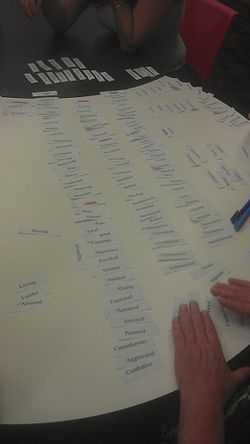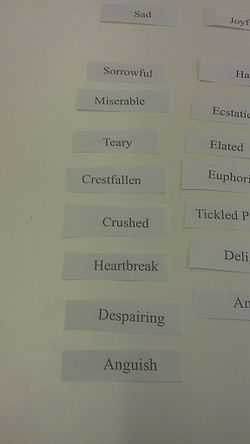Motivation and emotion/Tutorials/Emotion
< Motivation and emotion < TutorialsTutorial 04: Emotion
| |
Resource type: this resource contains a tutorial or tutorial notes. |
This is the fourth tutorial for the Motivation and emotion unit of study.
Core emotion sort
The goal of this exercise is to consider English language terms used to described human emotions and to arrange these terms into a model which depict underlying families of distinct emotional experience.
Some criteria for a core/basic emotion (Reeve, 2009, p. 312):
- Innate
- Arise from same circumstances
- Expressed uniquely and distinctively
- Predictable physiological response
Reasons some words might not be accepted as indicative of core emotions (Reeve, 2009, p. 336)
- Derivative or blended (non-core) emotions
- Moods
- Attitudes
- Personality traits
- Disorders
- Behaviours
Hand-out the list of specific emotions (per small group)
- Cut up the emotion words - need scissors and lots of table space
- Sort the emotion words into categories that represent core emotions - try not to be restricted or overly-guided by previous theory - go with what seems to make sense.
- Label each major emotion grouping - may include sub-groups
- Consider organising the emotions into a model (e.g., Plutchik's Wheel of Emotions - list of emotions (Wikipedia))
- Discuss amongst group members and agree on an overall organised model of the emotions
- Share and discuss each groups' model with the rest of the class
-

Emotion sort exercise under way...
-

Words which refer to aspects of "sad" emotions.
Emotion knowledge
This core emotion sort exercise is also designed to expand "emotion knowledge", which is the "number of different emotions any one person can distinguish" (e.g., the various shades of anger, including fury, hostility etc.) (Reeve, 2009, p. 352) and is part of emotional intelligence).
Part of the challenge in improving emotion knowledge is to expand one's linguistic taxonomy about our emotional repertoire, including the detail and nuance of our emotional variability. Reeve (2009, p. 353) suggests that "the finer and more sophisticated one's emotion knowledge is, the greater his or her capacity to respond to each life event with a specialised and highly appropriate reaction".
PANAS: Positive and Negative Affect Schedule
| |
Search for Positive Affect Negative Affect Schedule on Wikipedia. |
- Discuss difference between emotion and mood (p. 322)
- Complete and score the 20-item PANAS
- Compare Positive Affect (PA) and Negative Affect (NA) scores with SMU undergraduate norms
- Discuss the PANAS versions and its psychometrics, including temporal framing, correlation between PA and NA, test-retest reliability, and PANAS-X forms and factors
Book chapter development
Working with images, tables, and layout

- Live demo (ask for a volunteer chapter):
- Search commons:Wiki commons for an image
- Edit a Wikiversity page and add an image using the Visual Editor, including positioning and captioning the image
- Repeat for a second image
- Show Google Advanced Image Search with License filtering to identify free to use images and dummy demo uploading such an image to Wiki Commons
- FAQ
- Embedding images - When editing source, try adding: [[File:Example.jpg|150px|right|thumb|Caption text here.]] - it will provide the image on the right
- Finding images - Wiki Commons e.g., commons:Category:Emotions
- Uploading images
- Other features to consider:
- Tables
- Coloured boxes - e.g., Pretty boxes
- Quizzes - see Quiz
See also
- Tutorial session notes - Instructor notes
- Emotional intelligence (Additional tutorial exercise)
- Motivation, optimism, and self (Previous tutorial)
- Individual emotions (Next tutorial)